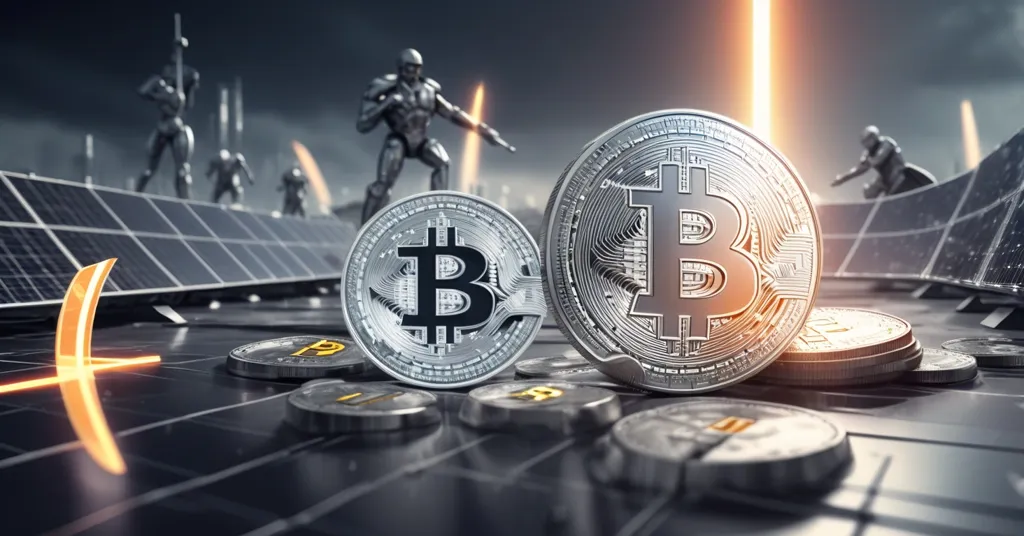Silver Breaks $50: Could $100 by 2026 Challenge Bitcoin’s Anti-Fiat Rebellion?

Silver Shatters $50 Mark: Could $100 by 2026 Rival Bitcoin’s Rebel Spirit?
Silver has blasted past $50 per ounce for the first time in over a decade, hitting $51 earlier this week with a staggering 78% year-to-date surge that’s leaving even gold in the dust. Driven by industrial hunger, supply shortages, and a flight to real assets amid inflation fears, analysts are now floating a bold $100 target by 2026. But as crypto enthusiasts, should we care about this old-school metal when Bitcoin already promises to upend fiat tyranny? Let’s dig into the hype, the risks, and the unexpected bridges between silver and decentralized tech.
- Price Breakthrough: Silver tops $50/oz, reaching $51, up 78% this year.
- Main Drivers: Industrial demand, tight supply, and inflation hedge appeal.
- Future Outlook: $100/oz by 2026 predicted, with near-term correction risks.
Silver’s Historic Surge: A Wake-Up Call
Last week, silver punched through the $50 per ounce barrier, a milestone not touched since its 2011 peak. By Monday morning, spot prices climbed to $51 with a 2.4% daily bump, while New York futures jumped 4.5% to around $49. This isn’t just a random spike—silver’s 78% gain in 2025 outpaces gold’s already meaty 50% rally, which itself set 39 new highs this year. For a metal long stuck in gold’s shadow, this feels like silver finally stepping into the ring with some serious muscle.
Why the sudden spotlight? Investors are scrambling for tangible assets as inflation eats away at fiat currencies and central banks keep the money printers humming. Silver fits the bill as a store of value, much like gold, but with a twist—it’s also a workhorse in the real world. Unlike gold, which mostly shines in vaults or on necks, silver powers modern life through its role in electronics, solar panels, and AI-driven semiconductor production. Its conductivity is unmatched, making it critical for photovoltaic cells (the tech that turns sunlight into energy in solar setups) and circuitry in everything from smartphones to data centers. With green energy and tech innovation on a tear, silver’s demand is hitting levels miners can’t match.
Paul Syms, Head of EMEA ETF fixed income and commodity product management at Invesco, captured the shift in market focus perfectly.
“Interest in silver picked up when the gold-silver ratio moved above 100x after the post ‘liberation day’ gold rally,” Syms said. “From an investment case standpoint, silver is also perceived as a store of value but has many industrial uses, particularly in electronics and renewable energy technologies.”
That gold-silver ratio he’s talking about is a key gauge for traders—it shows how many ounces of silver you can buy with one ounce of gold. Hitting over 100x, a rare extreme last seen during the pandemic, screamed that silver was dirt cheap compared to gold. Savvy investors took the hint, pouring capital into the underdog metal and fueling this record-breaking run.
Forces Powering the Rally: A Perfect Storm
Beyond investor sentiment, raw fundamentals are stoking silver’s fire. Supply is drying up while demand explodes—a nasty combo known as a structural deficit, where the world uses more silver than it digs out of the ground. Mining isn’t like flipping a switch; you can’t just crank out more overnight, no matter how much the market begs. Meanwhile, industries like renewable energy are gobbling up silver for solar tech, and the AI boom demands it for high-performance chips. It’s not just a hedge against fiat collapse—it’s a literal building block of the future.
Paul Williams, Managing Director at Solomon Global, laid out the gritty details behind this squeeze, with some experts predicting a massive price jump ahead.
“A deepening structural deficit, record industrial demand, and accelerating investment in green technologies are tightening supply and pushing prices higher,” Williams explained. “Given the current climate, a $100 silver price by 2026 is certainly possible by the end of 2026.”
Then there’s the broader economic backdrop. With geopolitical chaos, market volatility, and fiat currencies looking shakier by the day, commodities are riding a wave some call a supercycle—a prolonged bull run across raw materials. Philippe Gijsels, Chief Strategy Officer at BNP Paribas Fortis, sees this as just the opening salvo.
“We are still closer to the beginning than to the end of what could well become one of the largest bull markets in recorded history,” Gijsels stated. “I would not be surprised to see silver well north of $100 in the not-too-distant future.”
He also pointed to the psychological pull of milestone numbers, a quirk of human nature in markets.
“Big round numbers tend to attract investors like a magnet. Once that price gets in the gravitational field of the big numbers, we typically see an acceleration and a buying climax,” Gijsels added.
Risks and Reality Checks: Don’t Get Too Cozy
Before you start hocking family heirlooms to buy silver bars, let’s slap some cold water on the hype. Technical charts are screaming “overbought,” meaning prices may have shot up too fast, too soon—a setup where profit-takers could trigger a sharp, ugly drop. Think of it as a crypto pump-and-dump, just with shinier collateral. History backs this caution: silver’s infamous 1980 bubble, driven by the Hunt Brothers’ attempt to corner the market, saw prices skyrocket to $50 before crashing over 50% in months. Even the 2011 peak near $49 crumbled under speculative froth. Sure, today’s rally has stronger industrial legs, but markets don’t care about your feelings when momentum flips.
Another wildcard lurks on the horizon. While silver’s conductivity makes it king in tech for now, alternatives like graphene or advanced alloys could, in time, steal its thunder in applications like solar or electronics. It’s a long shot, and not imminent, but ignoring innovation’s pace would be naive—something we crypto folks know all too well from watching altcoins disrupt stale paradigms. So while the $100 forecast isn’t pure fantasy, it’s no guarantee either. Markets are brutal, and silver’s sprint could still face a faceplant.
Silver Meets Crypto: An Unlikely Tag Team?
Now, let’s pivot to why this old-world metal matters to us in the crypto sphere. At its core, silver’s surge taps into the same distrust of fiat systems that birthed Bitcoin. Both are bets against centralized overreach—silver as a physical shield, Bitcoin as a digital sword. When inflation rages and central banks debase currencies, folks flock to anything that holds value outside their grip. Silver needs trucks and vaults; Bitcoin just needs a seed phrase. Guess which one’s easier to sneak past borders or tyrannical regimes?
Yet silver’s utility gives it a niche Bitcoin doesn’t touch. You can’t build a solar panel with satoshis, and no amount of hodling will power a semiconductor. For crypto investors, silver offers diversification—a way to hedge against volatility without betting the farm on all-digital assets. Bitcoin maximalists might scoff, arguing physical metals are relics tethered to centralized mining and storage woes, while BTC’s scarcity is coded and unstoppable. Fair point, but not everyone’s ready to go full cypherpunk. Some want a tangible fallback, and silver’s industrial demand adds a layer of “real” that even gold struggles to match.
There’s another angle here: blockchain itself could revolutionize how silver is traded. Tokenization—turning physical assets into digital tokens on chains like Ethereum—could make buying and selling silver as easy as swapping ERC-20s, no middlemen needed. Imagine fractional ownership of silver bars via smart contracts, or using Bitcoin’s Lightning Network for microtransactions tied to silver prices. Projects are already exploring this, aiming to bring transparency to commodity supply chains plagued by fraud or inefficiency. If a blockchain can track a banana from farm to store, why not a silver ingot from mine to market? For newcomers, this is decentralization in action: cutting out gatekeepers and giving power back to the individual, whether the asset is bits or bullion.
What’s Next for Investors: A Dual Rebellion?
Looking ahead, silver’s trajectory to $100 by 2026 hinges on whether industrial demand and supply gaps keep tightening. Analysts are bullish, and the commodities cycle could indeed be a historic beast, but near-term stumbles are likely. For us in the crypto crowd, silver’s rally isn’t just a distraction—it’s a mirror to Bitcoin’s own war on fiat. Both challenge the status quo, just in different battlegrounds. Silver’s physical heft complements Bitcoin’s untouchable code, and blockchain tech might soon tie them closer than ever.
So, as silver claws its way up, consider this: Could it stand shoulder-to-shoulder with Bitcoin in the fight for financial freedom, or does it merely remind us why digital gold might be the only true insurgency? That’s the million-dollar—or $100-per-ounce—question.
Key Takeaways and Questions
- What’s driving silver’s leap past $50 per ounce?
A killer combo of industrial demand for tech like solar panels and AI chips, shrinking supply from mining constraints, and investors seeking safety from inflation and fiat decay. - How does silver compare to Bitcoin as an inflation hedge?
Silver’s 78% gain this year outstrips many crypto runs, offering a physical asset versus Bitcoin’s digital scarcity, though it lacks the borderless, decentralized punch of BTC. - Is the $100 silver price by 2026 a pipe dream?
It’s within reach if supply deficits and green tech demand persist, but overbought signals warn of harsh pullbacks, much like crypto’s infamous rug pulls. - Why should crypto fans give a damn about silver?
It shares Bitcoin’s anti-fiat ethos, providing a tangible diversification option for those not fully sold on all-digital portfolios, especially with real-world utility. - Can blockchain tech reshape silver markets?
Hell yes—tokenizing silver on platforms like Ethereum could simplify trading, while blockchain transparency might root out supply chain scams or inefficiencies in mining.



